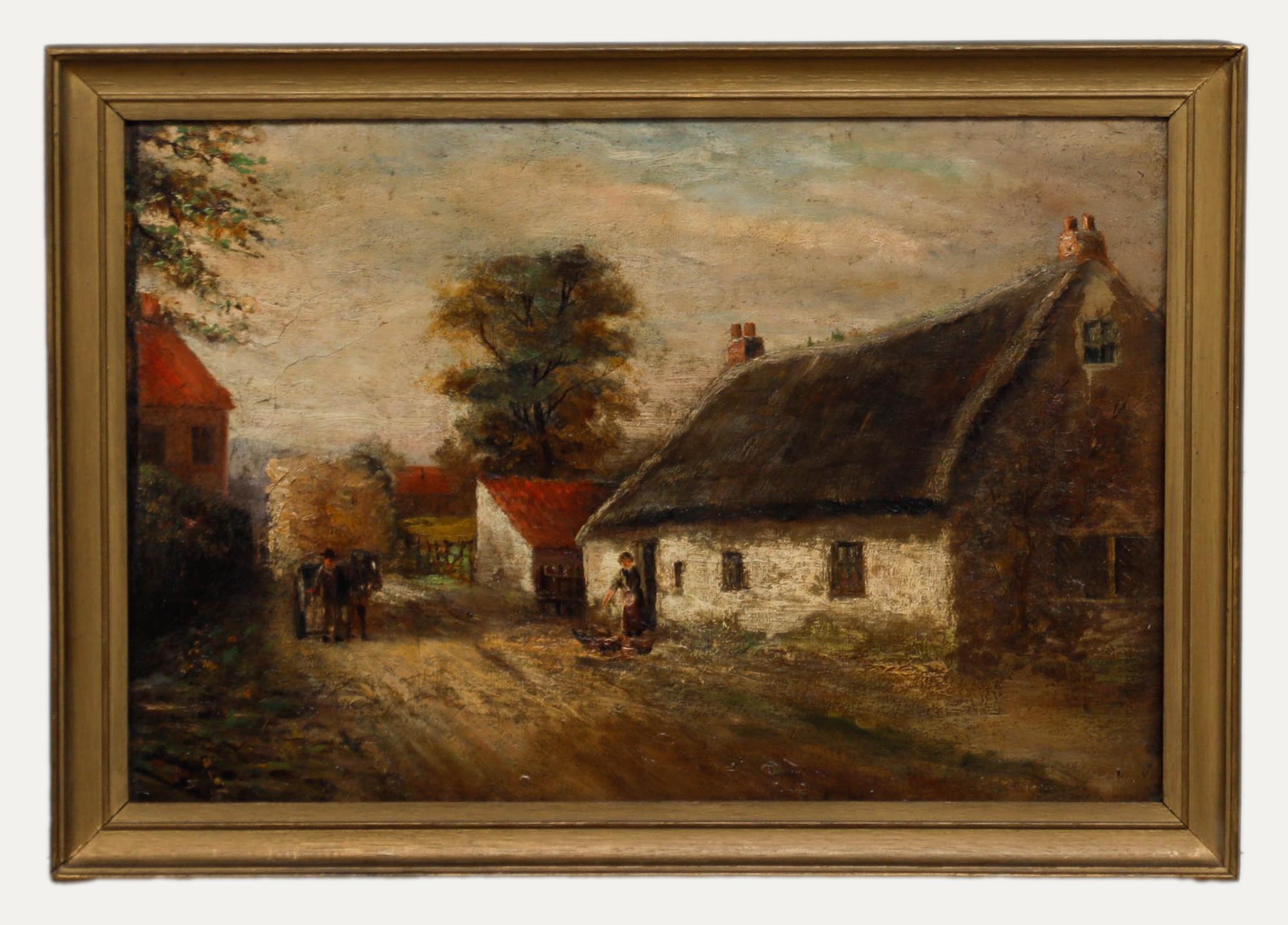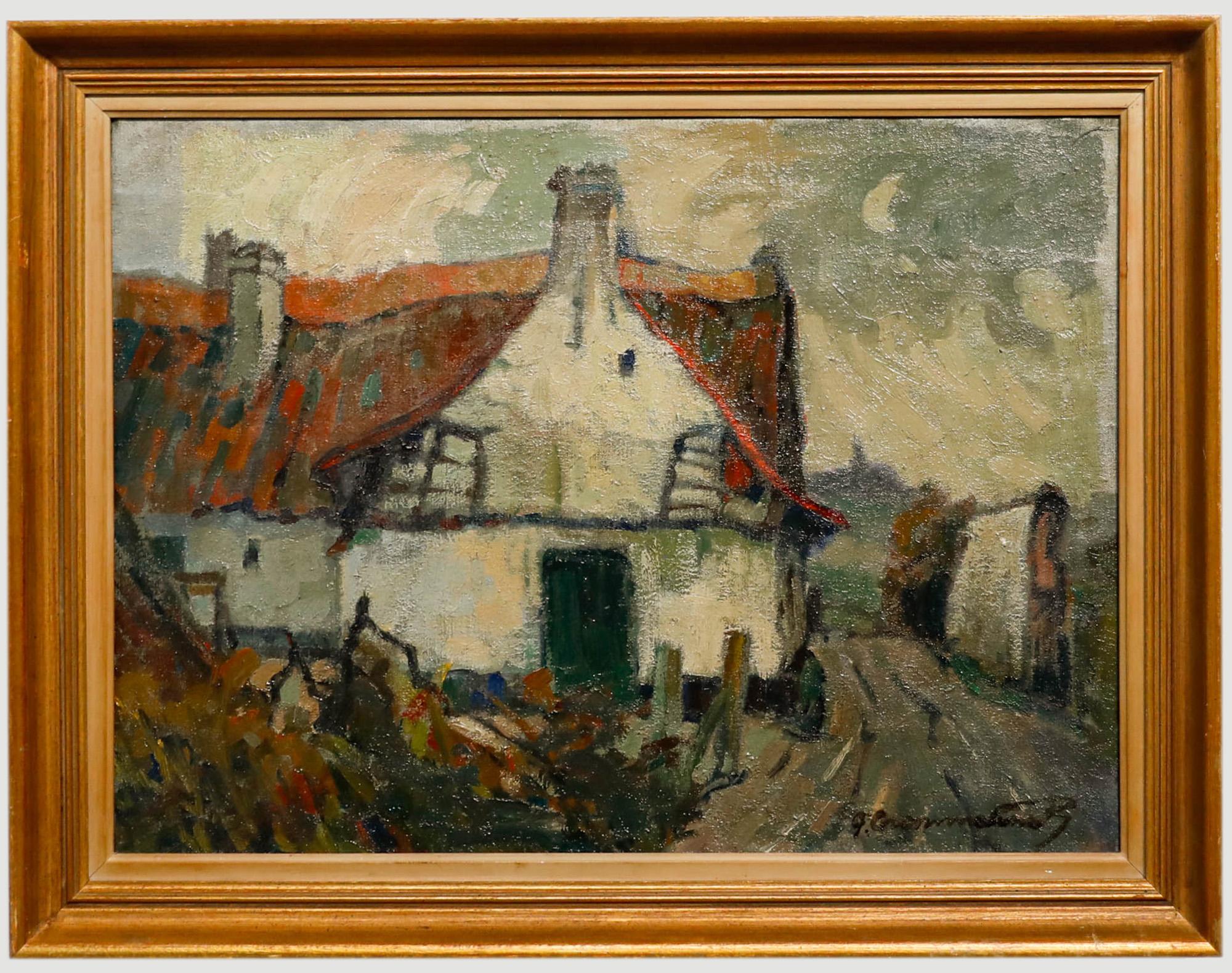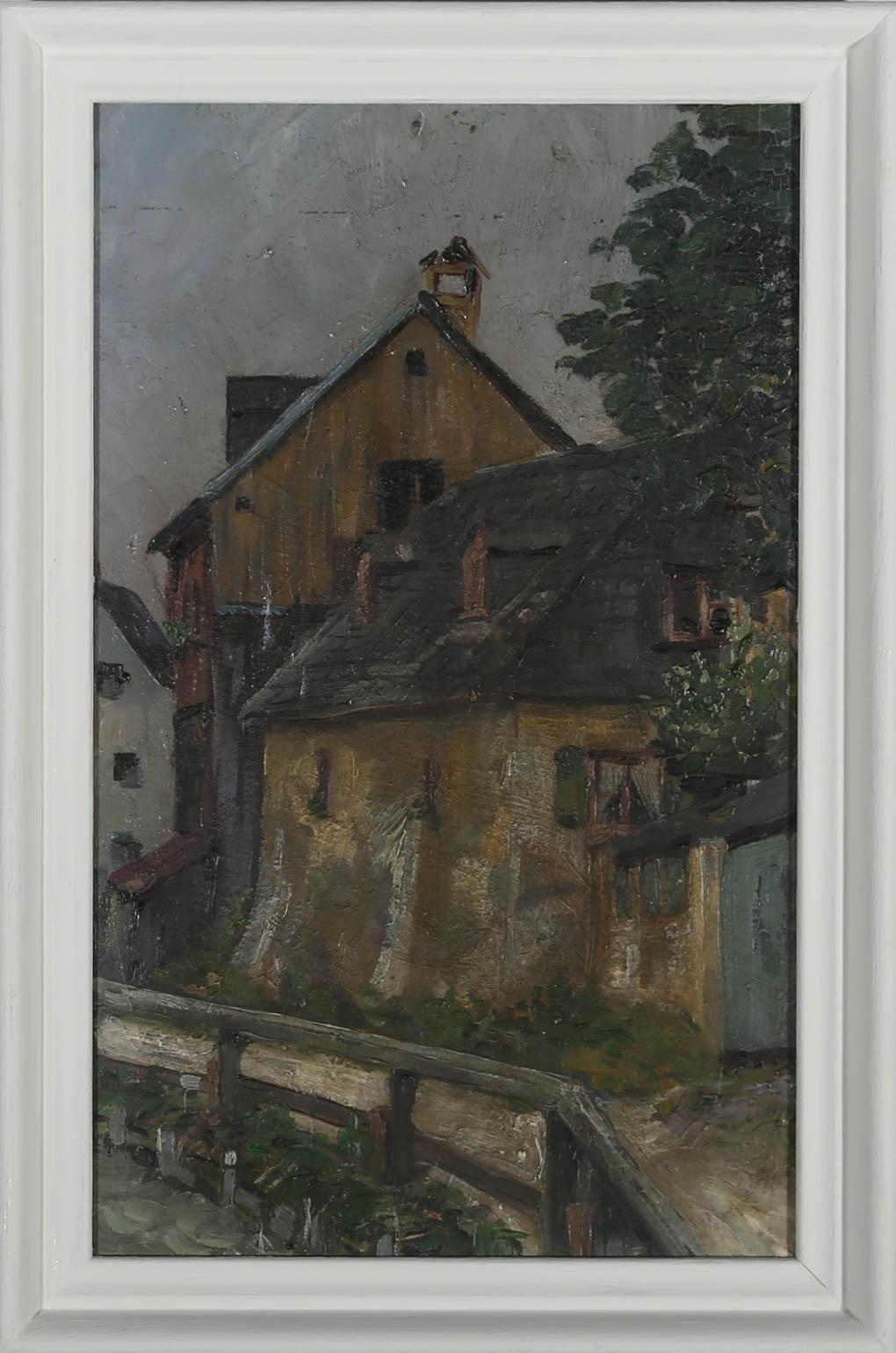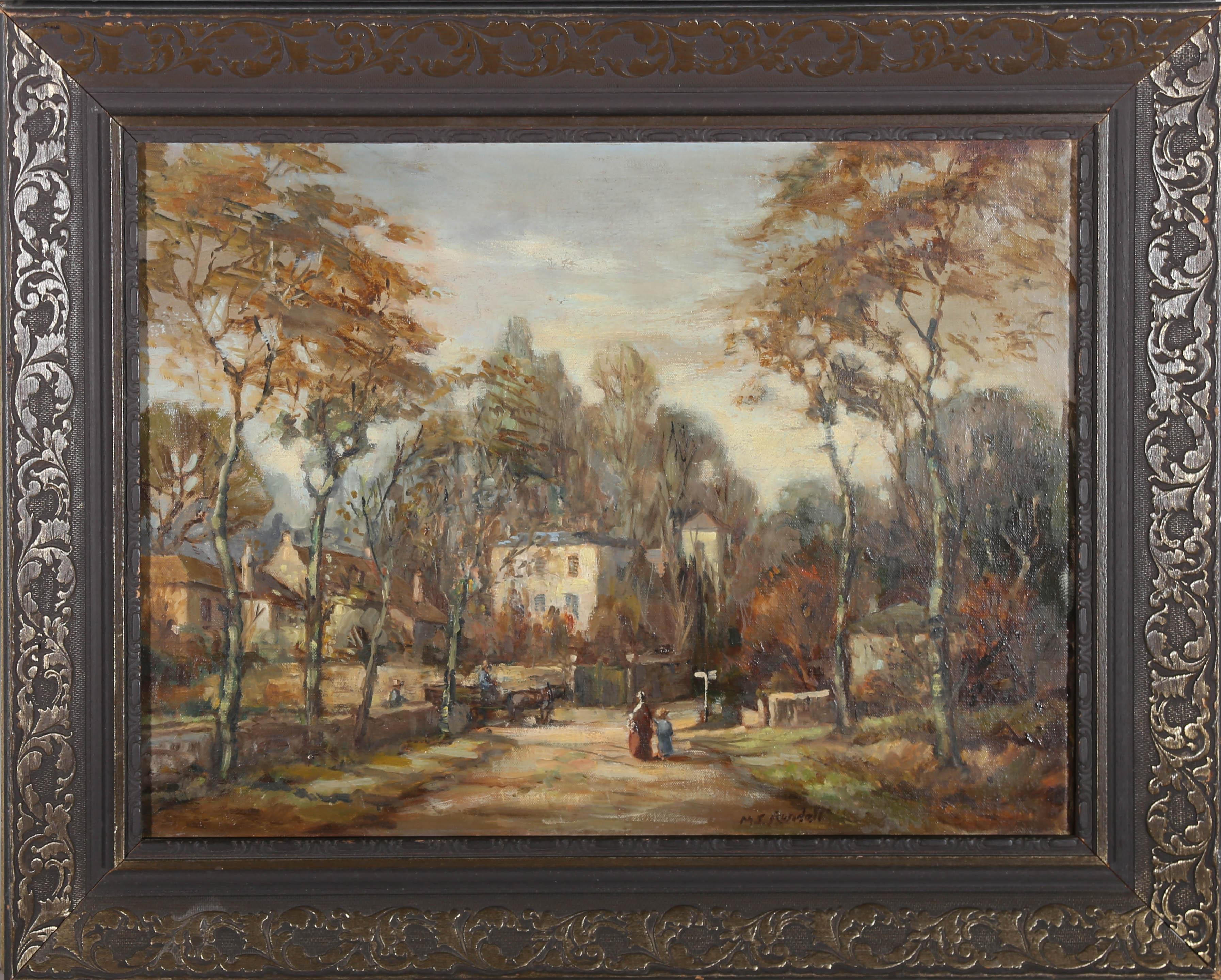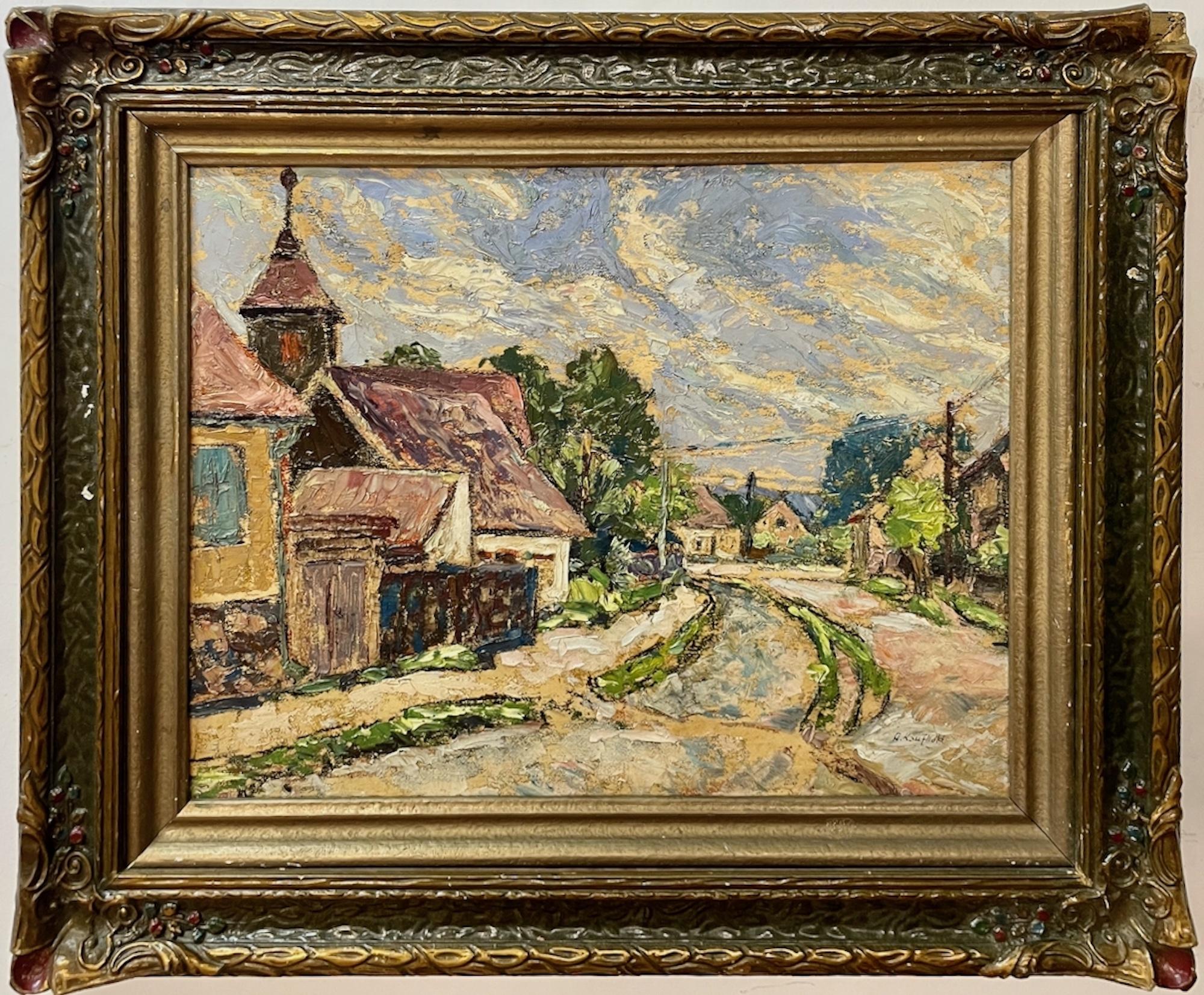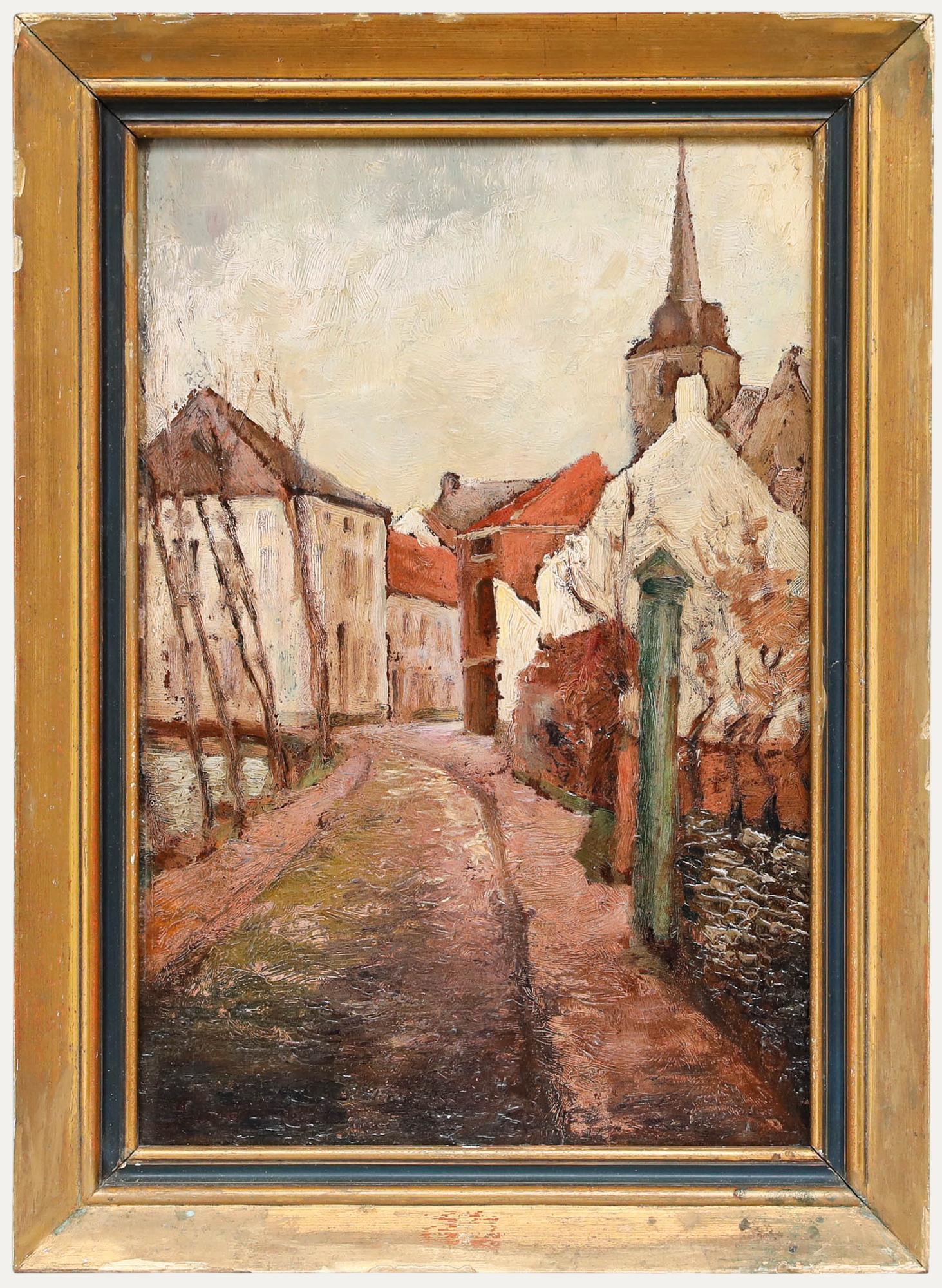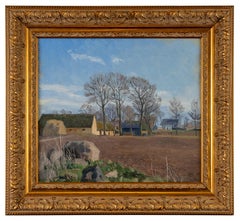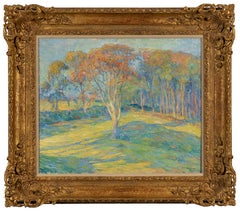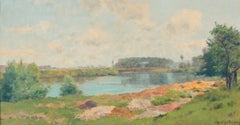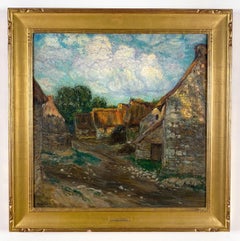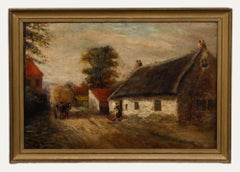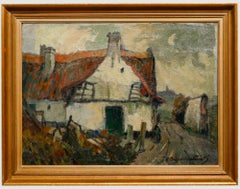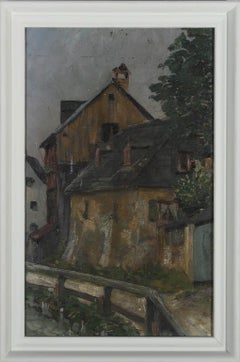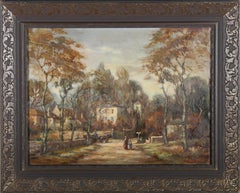Items Similar to Morning in the Village
Want more images or videos?
Request additional images or videos from the seller
1 of 8
Henry Ward RangerMorning in the Village
$3,400
£2,581.70
€2,952.37
CA$4,750.29
A$5,283.36
CHF 2,758.81
MX$64,292.91
NOK 35,234.19
SEK 33,043.45
DKK 22,034.65
Shipping
Retrieving quote...The 1stDibs Promise:
Authenticity Guarantee,
Money-Back Guarantee,
24-Hour Cancellation
About the Item
Henry Ward Ranger
American, 1858-1915
Morning In the Village
Oil on Academy Board
12 by 16 in, w/ frame 19 ¼ by 23 ¼ in
Signed lower right
A key person in the establishment of the Old Lyme, Connecticut art colony in 1899, Henry Ward Ranger is regarded as the leader of the Tonalist movement in America and was a leading painter in this country in the late 19th and early 20th-centuries.
He was born in Geneseo and raised in Syracuse, New York, and in 1873, enrolled in the College of Fine Arts at Syracuse University, where his father was a professor of photography and drawing. Two years later, he became a re-toucher of paintings in his father's studio and did not earn a college degree.
He also spent much time in New York City, where he was a writer of music criticism and visited galleries, where he had his first exposure to French Barbizon painting. During much of the 1880s, he painted watercolors of marine subjects, and exhibited those in New York City, Boston, and Paris.
As a student in France, he became greatly interested in the Barbizon School of painters, and then a trip to The Hague, Holland, was even more influential when he met a large colony of Dutch painters called "The Hague School", whose emphasis was on Realism and Tonalism.
Their soft, Atmospheric and Tonalist style of sombre colors seemed to suit him. However, his soft colors later became a special problem for anyone trying to restore his paintings as it was difficult to distinguish original color from soil on canvases. He did his sketches "en plein air" but finished his paintings in his studio and often exhibited his sketches and paintings together.
In 1885, Ranger moved to New York City and took up easel painting increasingly favoring oils over watercolors. In 1892, he had a one-man exhibition at the Knoedler Galleries in New York City. Many of his works in that show were forest interiors and tree studies.
Gradually his palette lightened with color and luminosity suggesting the influence of George Inness. In the summer of 1899, Ranger discovered Florence Griswold's boardinghouse in Old Lyme, Connecticut, and he returned in the summer of 1900. With his influence and the friendship of Florence Griswold, he became the leader of the artists' colony of Old Lyme, "an American version of Barbizon" (Lowrey 162) for three years.
However, the prevalent style changed to Impressionism with the 1903 arrival of Childe Hassam. He became disenchanted with painting at Old Lyme with the arrival of Childe Hassam in 1903 and the subsequent influence of his Impressionist style. In protest of the plein-air, fast painting, and lightened palette and abstraction of these Impressionists, Ranger, in 1905, moved farther down the coast to Noank, Connecticut near the mouth of the Mystic River.
Like many of his associates, he also maintained a studio in New York City where he was very prominent and often lectured and wrote about art and took an active part in the art community. He was a member of the National Academy of Design and the National Arts Club, and he wrote articles about art that were published.
When Henry Ward Ranger died in 1916, he was a childless widower and left his estate to the National Academy of Design to establish the Ranger Fund whose income was to purchase the works of living American artists beyond the age of forty-five.
- Creator:Henry Ward Ranger (1858 - 1916, American)
- Dimensions:Height: 19.25 in (48.9 cm)Width: 23.25 in (59.06 cm)
- More Editions & Sizes:19 ¼ by 23 ¼ inPrice: $3,400
- Medium:
- Movement & Style:
- Period:
- Condition:
- Gallery Location:Sheffield, MA
- Reference Number:Seller: 015661stDibs: LU700315922622
Henry Ward Ranger
A key person in the establishment of the Old Lyme, Connecticut art colony in 1899, Henry Ward Ranger is regarded as the leader of the Tonalist movement in America and was a leading painter in this country in the late 19th and early 20th-centuries. He was born in Geneseo and raised in Syracuse, New York, and in 1873, enrolled in the College of Fine Arts at Syracuse University, where his father was a professor of photography and drawing. Two years later, he became a re-toucher of paintings in his father's studio and did not earn a college degree. He also spent much time in New York City, where he was a writer of music criticism and visited galleries, where he had his first exposure to French Barbizon painting. During much of the 1880s, he painted watercolors of marine subjects, and exhibited those in New York City, Boston, and Paris. As a student in France, he became greatly interested in the Barbizon School of painters, and then a trip to The Hague, Holland, was even more influential when he met a large colony of Dutch painters called "The Hague School", whose emphasis was on Realism and Tonalism. Their soft, Atmospheric and Tonalist style of sombre colors seemed to suit him. However, his soft colors later became a special problem for anyone trying to restore his paintings as it was difficult to distinguish original color from soil on canvases. He did his sketches "en plein air" but finished his paintings in his studio. In 1885, Ranger moved to New York City and took up easel painting increasingly favoring oils over watercolors. In 1892, he had a one-man exhibition at the Knoedler Galleries in New York City. Many of his works in that show were forest interiors and tree studies. Gradually his palette lightened with color and luminosity suggesting the influence of George Inness. In the summer of 1899, Ranger discovered Florence Griswold's boardinghouse in Old Lyme, Connecticut, and he returned in the summer of 1900. With his influence and the friendship of Florence Griswold, he became the leader of the artists' colony of Old Lyme, "an American version of Barbizon" for three years. However, the prevalent style changed to Impressionism with the 1903 arrival of Childe Hassam. He became disenchanted with painting at Old Lyme with the arrival of Childe Hassam in 1903 and the subsequent influence of his Impressionist style. In protest of the plein-air, fast painting, and lightened palette and abstraction of these Impressionists, Ranger, in 1905, moved farther down the coast to Noank, Connecticut near the Mystic River. Like many of his associates, he also maintained a studio in New York City where he was very prominent and often lectured and wrote about art and took an active part in the art community. He was a member of the National Academy of Design and the National Arts Club, and he wrote articles about art that were published.
About the Seller
4.2
Vetted Professional Seller
Every seller passes strict standards for authenticity and reliability
1stDibs seller since 2017
55 sales on 1stDibs
Typical response time: 7 hours
- ShippingRetrieving quote...Shipping from: Sheffield, MA
- Return Policy
Authenticity Guarantee
In the unlikely event there’s an issue with an item’s authenticity, contact us within 1 year for a full refund. DetailsMoney-Back Guarantee
If your item is not as described, is damaged in transit, or does not arrive, contact us within 7 days for a full refund. Details24-Hour Cancellation
You have a 24-hour grace period in which to reconsider your purchase, with no questions asked.Vetted Professional Sellers
Our world-class sellers must adhere to strict standards for service and quality, maintaining the integrity of our listings.Price-Match Guarantee
If you find that a seller listed the same item for a lower price elsewhere, we’ll match it.Trusted Global Delivery
Our best-in-class carrier network provides specialized shipping options worldwide, including custom delivery.More From This Seller
View AllFarm in Autumn
Located in Sheffield, MA
Einar William Bogh
Danish, 1877-1938
Farm in Autumn
Oil on canvas
16 by 18 in, w/ frame 22 ⅝ by 24 ¾ in
Signed lower right
Painter in Esbonderup and Copenhagen, studied at the Kris...
Category
Early 20th Century Impressionist Landscape Paintings
Materials
Oil
Spring Landscape
By George Laurence Nelson
Located in Sheffield, MA
George Laurence Nelson
American, 1887-1978
Spring Landscape
Oil on canvas
20 ⅛ by 24 ⅛ in, w/ frame 28 by 32 in
Signed and dated 1912 lower right
George Laurence Nelson was born in...
Category
1910s Impressionist Landscape Paintings
Materials
Oil
French Countryside
Located in Sheffield, MA
Charles Charlay-Pompon
French, 1854-1914
French Countryside
Oil on canvas
Signed lower right
11 by 21 in. w/frame 16 ½ by 26 ½ in.
Charles Charl...
Category
1880s Impressionist Landscape Paintings
Materials
Oil
Brittany
Located in Sheffield, MA
Edward Francis Rook
American, 1870-1960
Brittany
Oil on Canvas
30 by 30 in. W/frame 38 by 38 in.
Signed lower left
Circa, 1898-1900
Rook, born in New York City on September 21, 1870, became one of the most original impressionists at Old Lyme. First he was a student of Benjamin Constant and Jean-Paul Laurens at the Académie Julian. Life started out to be rather promising for Rook, around the turn of the century. He exhibited at the Cincinnati Art Museum and at the Pennsylvania Academy of the Fine Arts, both in 1898, when his harbor scene, entitled Pearl Clouds — Moonlight was reproduced in International Studio, in April. In addition, the PAFA presented him with the Temple Gold Medal for Deserted Street, Moonlight, which the Academy purchased. Three years later, Rook was awarded a bronze medal at the Pan-American Exposition in Buffalo, where he exhibited three landscapes. Caffin (1902, p. xxxvi) praised the artist's "translucent quality of color," which suggests a study of color theory. Also in 1901, Rook married Edith Sone. For most of 1902, the Rooks were in Mexico.
Rook came to Old Lyme in October of 1903. The date is significant because Childe Hassam was also there that month. Hassam would more or less re-orient the artists' colony from Tonalism to impressionism. Rook would move there permanently two years later.
He took two medals at the St. Louis Universal Exposition (1904) where his landscapes from the Mexican trip were displayed. More awards followed: a silver medal at the International Fine Arts Exposition in Buenos Aires, 1910, a gold medal at San Francisco's Panama-Pacific International Exposition in 1915, a Corcoran Bronze Medal, and a William A. Clark Award in 1919 for Peonies. By 1924, the artist was made a National Academician. Despite all these awards and recognition, Rook did little in the way of selling his art and reportedly, his prices were too high. His paintings were handled by Macbeth and Grand Central Art Galleries.
Rook was active in Old Lyme's art community. As stated above, he would have met Hassam that October in 1903 but Willard Metcalf had departed at the end of the summer. As several writers have explained (Connecticut and American Impressionism, 1980, p. 123), Hassam "was the catalyst around whom [impressionism] coalesced." Rook's niece, Virginia Rook Garver, who happened to be the grand-niece of Hassam, confirmed that Rook and Hassam knew each other in Europe — before they went to Old Lyme (Fischer, 1987, p. 19).
Rook was one of the relatively young painters to come to Old Lyme, along with Gifford Beal, William Chadwick, and Robert Nisbet, on the wave of impressionism, initiated there by Hassam and Metcalf. Old Lyme became a center of American impressionism, and as Donelson F. Hoopes remarked, "under Hassam, the shoreline of Connecticut became a kind of Giverny of America." Among Ranger's group, palettes started to become lighter, except those of the most determined tonalists. Ranger himself, perhaps admitting defeat, moved to Noank in 1904.
Rook is best known for his views of Bradbury's Mill, which was soon called Rook's Mill, owing to the painter's many versions of the scene. One, called Swirling Waters, dated ca. 1917, is in the Lyme Historical Society. Even more famous is Rook's Laurel, dated between 1905 and 1910 (Florence Griswold Museum), in which a profuse laurel bush (the state flower), is set off by a spectacular Constable-like background. But Swirling Waters could never be confused with Constable, with its violent brushwork, impasto-layered water, and bright, almost chalky, plein-air palette. Gerdts (1984, p. 226) compares the paintings of Walter...
Category
1890s Post-Impressionist Landscape Paintings
Materials
Oil
Afternoon In the Garden
Located in Sheffield, MA
American School
American, 19th century
Afternoon In the Garden
Oil on canvas
8 ¼ by 18 in, w/ frame 13 ¼ by 23 ½ in
Category
19th Century Impressionist Landscape Paintings
Materials
Oil
$5,400
Rue de Village et Maisons
By Paul-Élie Gernez
Located in Sheffield, MA
Paul-Élie Gernez
French, 1888-1948
Rue de Village et Maisons
Oil on Canvas
23 ¾ by 28 ¾ in, w/ frame 34 ½ by 39 ½ in
Signed lower right
Paul-Élie Gernez (1888–1948) was a French pa...
Category
Mid-20th Century Modern Landscape Paintings
Materials
Oil
You May Also Like
19th Century Oil - Morning At The Farmstead
Located in Corsham, GB
Unsigned. Presented in a gilt effect wooden frame. On canvas.
Category
19th Century Landscape Paintings
Materials
Oil
$308 Sale Price
20% Off
Continental School Early 20th Century Oil - Edge of the Village
Located in Corsham, GB
A striking gestural work in oil showing a line of weathered houses, standing firm at the side of a quiet country road. Presented in an attractive giltwood frame. Illegibly signed to ...
Category
20th Century Landscape Paintings
Materials
Oil
$358 Sale Price
20% Off
Early 20th Century Oil - The Village Street
Located in Corsham, GB
A charming impressionist study of a quiet village street. The artist uses a muted colour palette to capture the lonely street after sunset. Unsigned. Pre...
Category
Early 20th Century Landscape Paintings
Materials
Oil
$254 Sale Price
20% Off
M.J. Rundell - 20th Century Oil, A Walk Through The Village
Located in Corsham, GB
Well presented in a dark vintage frame with gilt detail. Signed. On canvas on stretchers.
Category
21st Century and Contemporary Landscape Paintings
Materials
Oil
$328 Sale Price
20% Off
(Untitled) Dramatic Impressionist Landscape
Located in San Francisco, CA
Not a light and fluffy work, this dramatic impressionist landscape of a European village scene shortly after rainfall captures the moment when the sunshine is just breaking through a...
Category
Early 20th Century Impressionist Landscape Paintings
Materials
Canvas, Oil
Continental School Early 20th Century Oil - A Winter Street Scene
Located in Corsham, GB
This charming early 20th century painting depicts a quaint village street lined with rustic buildings, dominated by a prominent church spire in the background. Unsigned. Well present...
Category
20th Century Landscape Paintings
Materials
Oil
More Ways To Browse
Antique Village Soft
Dutch Paintings Hague School
Antique Original Paintings Boston
Used Morning Suit
W Ward Artist
Bentley Sign
Guinness Paintings
I Love Lucy
Impressionist Harvest
Used Horse Barn
Canoe Painting
Dutch Seascape
Jury Chair
Leap Of Faith
Luxembourg Gardens Paris
River Bend
Seashore Painting
Seine River Oil On Canvas
